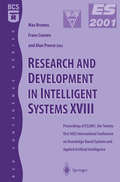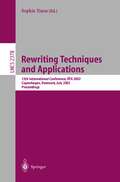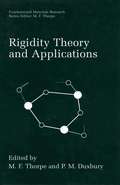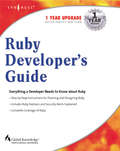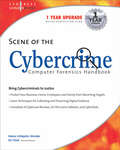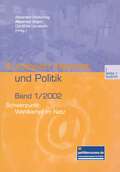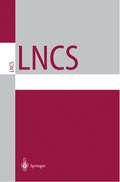- Table View
- List View
Research and Advanced Technology for Digital Libraries: 6th European Conference, ECDL 2002, Rome, Italy, September 16-18, 2002, Proceedings (Lecture Notes in Computer Science #2458)
by Costantino ThanosECDL 2002 was the 6th conference in the series of European Conferences on Research and Advanced Technologies for Digital Libraries. Following previous events in Pisa (1997), Heraklion (1998), Paris (1999), Lisbon (2000), and Da- stadt (2001), this year ECDL was held in Rome. ECDL 2002 contributed, - gether with the previous conferences, to establishing ECDL as the major - ropean forum focusing on digital libraries and associated technical, practical, and social issues. ECDL 2002 continued the tradition already established by the previous conferences in meeting the needs of a large and diverse constituency, which includes researchers, practitioners, educators, policy makers, and users. The focus of ECDL 2002 was on underlying principles, methods, systems, and tools to build and make available e?ective digital libraries to end users. Architecture, metadata, collection building, web archiving, web technologies,- books, OAI applications, preservation, navigation, query languages, audio video retrieval, multimedia-mixed media, user studies and evaluation, humanities, and digital libraries were some of the key issues addressed. An international Program Committee was set up composed of 61 members, with representatives from 25 countries. A total of 145 paper submissions, 15 poster submissions, and 18 proposals for demos were received. Each paper was evaluated by 3 referees and 42 full papers and 6 short papers of high quality were selected for presentation.
Research and Development in Intelligent Systems XVIII: Proceedings of ES2001, the Twenty-first SGES International Conference on Knowledge Based Systems and Applied Artifical Intelligence, Cambridge, December 2001 (Bcs Conference Ser.)
by Max Bramer BSc, PhD, CEng Frans Coenen Alun PreeceM.A. BRAMER University of Portsmouth, UK This volume comprises the refereed technical papers presented at ES200 l, the Twenty-fIrst SGES International Conference on Knowledge Based Systems and Applied ArtifIcial Intelligence, held in Cambridge in December 200 l, together with an invited keynote paper by Professor Derek Sleeman. The conference was organised by SGES, the British Computer Society Specialist Group on Knowledge Based Systems and Applied ArtifIcial Intelligence. The papers in this volume present new and innovative developments in the fIeld, divided into sections on Machine Learning, Constraint Satisfaction, Agents, Knowledge Representation, Knowledge Engineering, and Intelligent Systems. The refereed papers begin with a paper entitled 'Detecting Mismatches Among Experts' Ontologies Acquired Through Knowledge Elicitation', which describes a systematic approach to the analysis of discrepancies within and among experts' ontologies. This paper was judged to be the best refereed technical paper submitted to the conference. The remaining papers are devoted to topics in important areas such as agents, knowledge engineering, knowledge representation, planning and constraint satisfaction, with machine learning again the largest topic covered in terms of the number of papers accepted for publication. This is the eighteenth volume in the Research and Development series. The Application Stream papers are published as a companion volume under the title Applications and Innovations in Intelligent Systems IX.
Reuse Methodology Manual for System-on-a-Chip Designs
by Pierre BricaudThis revised and updated third edition outlines a set of best practices for creating reusable designs for use in an System-on-a-Chip (SoC) design methodology. These practices are based on the authors' experience in developing reusable designs, as well as the experience of design teams in many companies around the world.
Rewriting Techniques and Applications: 13th International Conference, RTA 2002, Copenhagen, Denmark, July 22-24, 2002 Proceedings (Lecture Notes in Computer Science #2378)
by Sophie TisonRigidity Theory and Applications (Fundamental Materials Research)
by M. F. Thorpe P. M. DuxburyAlthough rigidity has been studied since the time of Lagrange (1788) and Maxwell (1864), it is only in the last twenty-five years that it has begun to find applications in the basic sciences. The modern era starts with Laman (1970), who made the subject rigorous in two dimensions, followed by the development of computer algorithms that can test over a million sites in seconds and find the rigid regions, and the associated pivots, leading to many applications. This workshop was organized to bring together leading researchers studying the underlying theory, and to explore the various areas of science where applications of these ideas are being implemented.
RoboCup 2001: Robot Soccer World Cup V (Lecture Notes in Computer Science #2377)
by Andreas Birk Silvia Coradeschi Satoshi TadokoroRobot Building for Beginners
by Cathan Cook"Robot Building for Beginners" provides basic, practical knowledge on getting started in amateur robotics. Short chapters are perfectly suited for bedtime reading. It contains step-by-step instructions and small, hands-on experiments, including a line-following robot that the reader builds out of a sandwich container. By the end, the reader will make a palm-size solar robot and is also introduced to contests and potential project plans. Author David Cook begins with the anatomy of a homemade robot and advice on how to proceed successfully. General sources for tools and parts are provided in a consolidated listing and with specific part references throughout each chapter. Basic safety and numbering systems are also covered.
Robot Teams: From Diversity to Polymorphism
by Tucker Balch Lynne E. ParkerThis is a comprehensive volume on robot teams that will be the standard reference on multi-robot systems. The volume provides not only the essentials of multi-agent robotics theory but also descriptions of exemplary implemented systems demonstrating the key concepts of multi-robot research. Information is presented in a descriptive manner and augme
Robust Adaptation to Non-Native Accents in Automatic Speech Recognition (Lecture Notes in Computer Science #2560)
by Silke GoronzySpeech recognition technology is being increasingly employed in human-machine interfaces. A remaining problem however is the robustness of this technology to non-native accents, which still cause considerable difficulties for current systems.In this book, methods to overcome this problem are described. A speaker adaptation algorithm that is capable of adapting to the current speaker with just a few words of speaker-specific data based on the MLLR principle is developed and combined with confidence measures that focus on phone durations as well as on acoustic features. Furthermore, a specific pronunciation modelling technique that allows the automatic derivation of non-native pronunciations without using non-native data is described and combined with the previous techniques to produce a robust adaptation to non-native accents in an automatic speech recognition system.
Robust Modal Control with a Toolbox for Use with MATLAB®
by Jean-François MagniRobust Modal Control covers most classical multivariable modal control design techniques that were shown to be effective in practice, and in addition proposes several new tools. The proposed new tools include: minimum energy eigenvector selection, low order observer-based control design, conversion to observer-based controllers, a new multimodel design technique, and modal analysis. The text is accompanied by a CD-ROM containing MATLAB® software for the implementation of the proposed techniques. The software is in use in aeronautical industry and has proven to be effective and functional. For more detail, please visit the author's webpage at http://www.cert.fr/dcsd/idco/perso/Magni/booksandtb.html
Robust Speech Recognition in Embedded Systems and PC Applications (The Springer International Series in Engineering and Computer Science #563)
by Jean-Claude JunquaRobust Speech Recognition in Embedded Systems and PC Applications provides a link between the technology and the application worlds. As speech recognition technology is now good enough for a number of applications and the core technology is well established around hidden Markov models many of the differences between systems found in the field are related to implementation variants. We distinguish between embedded systems and PC-based applications. Embedded applications are usually cost sensitive and require very simple and optimized methods to be viable. Robust Speech Recognition in Embedded Systems and PC Applications reviews the problems of robust speech recognition, summarizes the current state of the art of robust speech recognition while providing some perspectives, and goes over the complementary technologies that are necessary to build an application, such as dialog and user interface technologies. Robust Speech Recognition in Embedded Systems and PC Applications is divided into five chapters. The first one reviews the main difficulties encountered in automatic speech recognition when the type of communication is unknown. The second chapter focuses on environment-independent/adaptive speech recognition approaches and on the mainstream methods applicable to noise robust speech recognition. The third chapter discusses several critical technologies that contribute to making an application usable. It also provides some design recommendations on how to design prompts, generate user feedback and develop speech user interfaces. The fourth chapter reviews several techniques that are particularly useful for embedded systems or to decrease computational complexity. It also presents some case studies for embedded applications and PC-based systems. Finally, the fifth chapter provides a future outlook for robust speech recognition, emphasizing the areas that the author sees as the most promising for the future. Robust Speech Recognition in Embedded Systems and PC Applications serves as a valuable reference and although not intended as a formal University textbook, contains some material that can be used for a course at the graduate or undergraduate level. It is a good complement for the book entitled Robustness in Automatic Speech Recognition: Fundamentals and Applications co-authored by the same author.
Role of GIS in Lifting the Cloud Off Chernobyl (NATO Science Series: IV: #10)
by JaromírKolejkaThe 15th anniversary of the Chernobyl nuclear power plant disaster offered a timely opportunity for an expert assessment of the current situation and suggestions for approaches to managing the information associated with the site and surrounding contaminated territories. The great quantity of data coming from the contaminated region was and is very difficult to use without he aid of modern information technologies, especially Geographic Information Systems (GIS) and Remote Sensing (RS). Application of these technologies, and related expertise, became crucial to the region's economic recovery and sustainability planning. Given the real possibility of a similar accident at nuclear facilities elsewhere around the world, the development of recovery strategies based on experience gained at Chernobyl, using modern scientific methods and technologies, will be invaluable in the future. The presentations and discussion reported in the book have led to some key conclusions. Image maps derived from satellite imagery are the most economical, up to date and readily available basis for Chernobyl-related applications, as well as for other future applications. The study of soil-plant transfer of radionuclides afforded comparatively much more reliable data. GIS in association with adequate knowledge is a valuable tool in decision making and modelling of contaminated areas and objects.
Rough Sets: Mathematical Foundations (Advances in Intelligent and Soft Computing #15)
by Lech PolkowskiA comprehensive introduction to mathematical structures essential for Rough Set Theory. The book enables the reader to systematically study all topics of rough set theory. After a detailed introduction in Part 1 along with an extensive bibliography of current research papers. Part 2 presents a self-contained study that brings together all the relevant information from respective areas of mathematics and logics. Part 3 provides an overall picture of theoretical developments in rough set theory, covering logical, algebraic, and topological methods. Topics covered include: algebraic theory of approximation spaces, logical and set-theoretical approaches to indiscernibility and functional dependence, topological spaces of rough sets. The final part gives a unique view on mutual relations between fuzzy and rough set theories (rough fuzzy and fuzzy rough sets). Over 300 excercises allow the reader to master the topics considered. The book can be used as a textbook and as a reference work.
Rough Sets and Current Trends in Computing: Third International Conference, RSCTC 2002, Malvern, PA, USA, October 14-16, 2002. Proceedings (Lecture Notes in Computer Science #2475)
by Andrzeij Skowron Ning Zhong James J. Alpigini James F. PetersThis volume contains the papers selected for presentation at the Third Inter- tional Conference on Rough Sets and Current Trends in Computing (RSCTC 2002) held at Penn State Great Valley, Malvern, Pennsylvania, U.S.A., 14–16 October 2002. Rough set theoryand its applications constitute a branch of soft computing that has exhibited a signi?cant growth rate during recent years. RSCTC 2002 provided a forum for exchanging ideas among manyresearchers in the rough set communityand in various areas of soft computing and served as a stimulus for mutual understanding and cooperation. In recent years, there have been a number of advances in rough set theoryand applications. Hence, we have witnessed a growing number of international workshops on rough sets and their applications. In addition, it should be observed that one of the beauties of rough sets and the rough set philosophyis that it tends to complement and reinforce research in manytraditional research areas and applications. This is the main reason that manyinternational conferences are now including rough sets into the list of topics.
Ruby Developers Guide
by SyngressAn expert guide to Ruby, a popular new Object-Oriented Programming LanguageRuby is quickly becoming a favourite among developers who need a simple, straight forward, portable programming language. Ruby is ideal for quick and easy object-oriented programming such as processing text files or performing system management. Having been compared with other programming languages such as Perl, Python, PCL, Java, Eiffel, and C++; Ruby is popular because of its straight forward syntax and transparent semantics.Using step-by-step examples and real world applications, the Ruby Developer's Guide is designed for programmers and developer's looking to embrace the object-oriented features and functionality of this robust programming language. Readers will learn how to develop, implement, organize and deploy applications using Ruby.Ruby is currently experiencing a rapid rise in popularity in the object-oriented programming communityReaders receive up-to-the minute links, white papers, and analysis for two years at solutions@syngress.comComes with a wallet-sized CD containing a printable HTML version of the book, all of the source code examples and demos of popular Ruby third-party programming tools and applications
Satellite Personal Communications for Future-generation Systems: Final Report: COSY 252 Action
by Enrico Del Re Laura PierucciConsisting of selected technical contributions to the European Project COST252, this volume provides many innovative results which can be the basis for new global telecommunications systems providing multimedia services at high rates. It also presents new perspectives on communications problems in various areas.
Scene of the Cybercrime: Computer Forensics Handbook
by Syngress"Cybercrime and cyber-terrorism represent a serious challenge to society as a whole." - Hans Christian Krüger, Deputy Secretary General of the Council of EuropeCrime has been with us as long as laws have existed, and modern technology has given us a new type of criminal activity: cybercrime. Computer and network related crime is a problem that spans the globe, and unites those in two disparate fields: law enforcement and information technology. This book will help both IT pros and law enforcement specialists understand both their own roles and those of the other, and show why that understanding and an organized, cooperative effort is necessary to win the fight against this new type of crime.62% of US companies reported computer-related security breaches resulting in damages of $124 million dollars. This data is an indication of the massive need for Cybercrime training within the IT and law enforcement communities.The only book that covers Cybercrime from forensic investigation through prosecution. Cybercrime is one of the battlefields in the war against terror.
Schwerpunkt: Wahlkampf im Netz (Kursbuch Internet und Politik #1)
by Alexander Siedschlag Alexander Bilgeri Dorothea LamatschDas Internet nimmt für Politik und Verwaltung eine immer größere Rolle ein. Parteien und Abgeordnete bauen ihre Webpräsenz aus, die Verwaltung setzt auf E-Government und der Bürger informiert sich zunehmend auch im Internet über politische Themen. Im Kursbuch Internet und Politik schreiben Experten aus Wissenschaft, Politik und E-Business zweimal jährlich zu den Wechselbeziehungen zwischen Politik, öffentlicher Verwaltung und Internet.
Security and Privacy in Digital Rights Management: ACM CCS-8 Workshop DRM 2001, Philadelphia, PA, USA, November 5, 2001. Revised Papers (Lecture Notes in Computer Science #2320)
by Tomas SanderThe ACM Workshop on Security and Privacy in Digital Rights Management is the ?rst scienti?c workshop with refereed proceedings devoted solely to this topic. The workshop was held in conjunction with the Eighth ACM Conference on Computer and Communications Security (CCS-8) in Philadelphia, USA on November 5, 2001. Digital Rights Management technology is meant to provide end-to-end so- tions for the digital distribution of electronic goods. Sound security and privacy features are among the key requirements for such systems. Fifty papers were submitted to the workshop, quite a success for a ?rst-time workshop. From these 50 submissions, the program committee selected 15 papers for presentation at the workshop. They cover a broad area of relevant techniques, including cryptography, system architecture, and cryptanalysis of existing DRM systems. Three accepted papers are about software tamper resistance, an area about which few scienti?c articles have been published before. Another paper addresses renewability of security measures. Renewability is another important security technique for DRM systems, and I hope we will see more publications about this in the future. I am particularly glad that three papers cover economic and legal aspects of digital distribution of electronic goods. Technical security measures do not exist in a vacuum and their e?ectiveness interacts in a number of ways with the environment for legal enforcement. Deploying security and an- piracy measures adequately requires furthermore a good understanding of the business models that they are designed to support.
Security in the Information Society: Visions and Perspectives (IFIP Advances in Information and Communication Technology #86)
by M. Adeeb Ghonaimy Mahmoud T. El-Hadidi Heba K. AslanRecent advances in technology and new software applications are steadily transforming human civilization into what is called the Information Society. This is manifested by the new terminology appearing in our daily activities. E-Business, E-Government, E-Learning, E-Contracting, and E-Voting are just a few of the ever-growing list of new terms that are shaping the Information Society. Nonetheless, as "Information" gains more prominence in our society, the task of securing it against all forms of threats becomes a vital and crucial undertaking. Addressing the various security issues confronting our new Information Society, this volume is divided into 13 parts covering the following topics: Information Security Management; Standards of Information Security; Threats and Attacks to Information; Education and Curriculum for Information Security; Social and Ethical Aspects of Information Security; Information Security Services; Multilateral Security; Applications of Information Security; Infrastructure for Information Security Advanced Topics in Security; Legislation for Information Security; Modeling and Analysis for Information Security; Tools for Information Security. Security in the Information Society: Visions and Perspectives comprises the proceedings of the 17th International Conference on Information Security (SEC2002), which was sponsored by the International Federation for Information Processing (IFIP), and jointly organized by IFIP Technical Committee 11 and the Department of Electronics and Electrical Communications of Cairo University. The conference was held in May 2002 in Cairo, Egypt.
Security Protocols: 9th International Workshop, Cambridge, UK, April 25-27, 2001 Revised Papers (Lecture Notes in Computer Science #2467)
by Bruce Christianson Bruno Crispo James A. Malcolm Michael RoeHello and welcome. These are the proceedings of the 9th International Workshop on Security Protocols, the ?rst to be held in the new millennium. This year our theme was “mobile computing versus immobile security”. As usual, the insights and challenges which emerged during the workshop are re?ected in the position papers, which appear here in rewritten form. Transcripts are also included of the discussions which took place in C- bridge as the initial versions were presented. These transcripts are intended to provide a perspective on lines of argument which are worth pursuing further. Our desire is that you will join with us in this activity, and that as a result you will, like many of our participants, feel moved to propound something quite di?erent from what you originally planned. Our thanks as always to Prof. Roger Needham, FRS and to Microsoft - search Ltd. (Cambridge) for the use of the meeting room and co?ee machine. Thanks also to Lori Klimaszewska of the University of Cambridge Computing Service for transcribing the audio tapes (and for revealing in “Audrey James” a previously unsuspected double life of a well-known double agent), and to Dr. Mary Buchanan for her assistance in editing the transcripts into a Thucydidean mould. Actually, we are often asked how we go about producing the transcripts, especially upon those occasions when, for various reasons, no audio recording was made. This year we bow to pressure and reveal the details of our methodology in the Afterword.
Selected Topics in Boundary Integral Formulations for Solids and Fluids (CISM International Centre for Mechanical Sciences #433)
by Vladimir KompisThe book outlines special approaches using singular and non-singular, multi-domain and meshless BEM formulations, hybrid- and reciprocity-based FEM for the solution of linear and non-linear problems of solid and fluid mechanics and for the acoustic fluid-structure interaction. Use of Trefftz functions and other regularization approaches to boundary integral equations (BIE), boundary contour and boundary node solution of BIE, sensitivity analysis, shape optimization, error analysis and adaptivity, stress and displacement derivatives in non-linear problems smoothing using Trefftz polynomials and other special numerical approaches are included. Applications to problems such as noise radiation from rolling bodies, acoustic radiation in closed and infinite domains, 3D dynamic piezoelectricity, Stefan problems and coupled problems are included.
Self-Organizing Neural Networks: Recent Advances and Applications (Studies in Fuzziness and Soft Computing #78)
by Udo SeiffertThe Self-Organizing Map (SOM) is one of the most frequently used architectures for unsupervised artificial neural networks. Introduced by Teuvo Kohonen in the 1980s, SOMs have been developed as a very powerful method for visualization and unsupervised classification tasks by an active and innovative community of interna tional researchers. A number of extensions and modifications have been developed during the last two decades. The reason is surely not that the original algorithm was imperfect or inad equate. It is rather the universal applicability and easy handling of the SOM. Com pared to many other network paradigms, only a few parameters need to be arranged and thus also for a beginner the network leads to useful and reliable results. Never theless there is scope for improvements and sophisticated new developments as this book impressively demonstrates. The number of published applications utilizing the SOM appears to be unending. As the title of this book indicates, the reader will benefit from some of the latest the oretical developments and will become acquainted with a number of challenging real-world applications. Our aim in producing this book has been to provide an up to-date treatment of the field of self-organizing neural networks, which will be ac cessible to researchers, practitioners and graduated students from diverse disciplines in academics and industry. We are very grateful to the father of the SOMs, Professor Teuvo Kohonen for sup porting this book and contributing the first chapter.
Semantic Models for Multimedia Database Searching and Browsing (Advances in Database Systems #21)
by Shu-Ching Chen R.L. Kashyap Arif GhafoorSemantic Models for Multimedia Database Searching and Browsing begins with the introduction of multimedia information applications, the need for the development of the multimedia database management systems (MDBMSs), and the important issues and challenges of multimedia systems. The temporal relations, the spatial relations, the spatio-temporal relations, and several semantic models for multimedia information systems are also introduced. In addition, this book discusses recent advances in multimedia database searching and multimedia database browsing. More specifically, issues such as image/video segmentation, motion detection, object tracking, object recognition, knowledge-based event modeling, content-based retrieval, and key frame selections are presented for the first time in a single book. Two case studies consisting of two semantic models are included in the book to illustrate how to use semantic models to design multimedia information systems. Semantic Models for Multimedia Database Searching and Browsing is an excellent reference and can be used in advanced level courses for researchers, scientists, industry professionals, software engineers, students, and general readers who are interested in the issues, challenges, and ideas underlying the current practice of multimedia presentation, multimedia database searching, and multimedia browsing in multimedia information systems.

